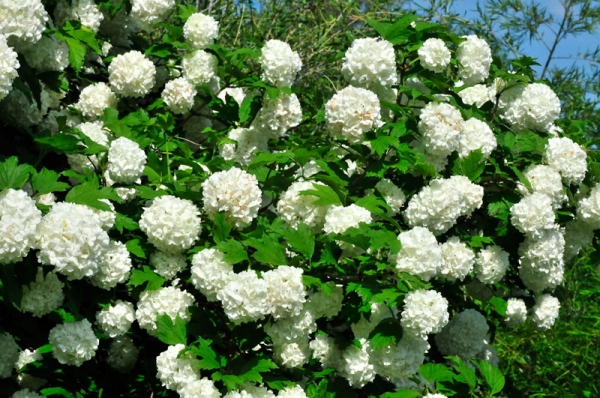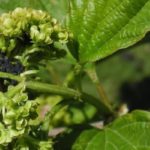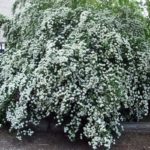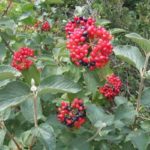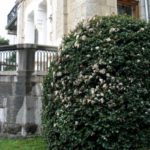Kalina Buldenezh is grown at dachas by gardeners, designers are used to decorate sites. Decorative variety Snowball was bred by a Frenchman named Lemoine four centuries ago. In Russia, the beauty came at the behest of the reigning Catherine II. Bushes plants at first could be seen in the greenhouses and parks of the imperial family. Later, the nobility began planting viburnum their gardens. They looked unique. The branches were covered with snow balls. The description of this ornamental plant is given below.
The “snow globe” is a type of ordinary viburnum, which takes its place in the honeysuckle family. Its height can be almost 3.5 m, diameter and a half.
Table of contents
What does a plant look like?
Shrub has a highly branched branches. Gardeners, pruning them, give the plant a semicircle shape. From this blooming buds become more beautiful and tender. Inflorescences in the form of a ball and on a dwarf tree look great.
The leaves of such a garden viburnum are large and bright, have notches, and the veins create an interesting pattern. They covered all the shoots. Looking at the plant, it seems that it is in a festive green dress.

Inflorescences in the form of a ball are formed on young branches. The diameter of each is 15 cm. From one bud out a few petals. Stamens in them. Therefore, the plant does not produce fruit.
By winter, the leaves fall off, but viburnum looks spectacular without them, since the relief is created artificially.
Open buds have a light green tint, then become creamy and pinkish. Having opened, become a snow-white lump. Because of the huge number of inflorescences shoots bend down. Such beauty can be observed for more than a month - to 35 days, flowering begins in May or June.
Now, the plants that are grown in the suburban region, grow to more than 6 meters in height and live more than 5 decades.
Choosing a place for landing
For single bushes, you can pick up a place on a well-groomed green lawn. They look great near the gazebo, pond, benches.
Viburnum will surprise with its color in group plantings. The elegance of the plant will give a neighborhood with other cultures - barberry, spireaforming darker foliage below.
The snow globe will not disappear even in poor soil, in the area where there is little light, but the inflorescences will be small and in small quantities. To the bushes or trees pleased exquisite snow-white buds,find a more hydrated place with soil acidity not exceeding 6.5. It is better to plant at the lake, fountain or well. Do it well in spring and autumn.
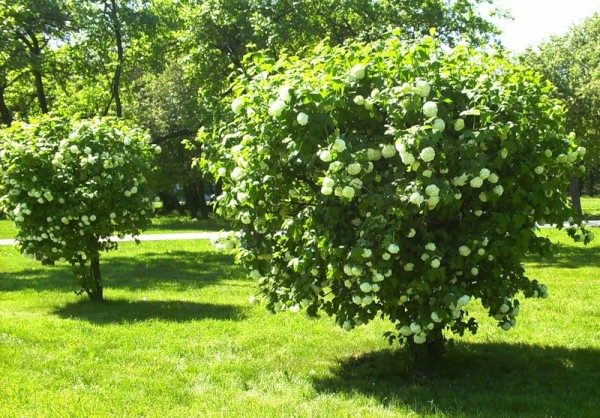
In the fertile land digging a hole 40x40in poor - to 60. Put peat, 30 grams of nitrogen and potassium, up to 50 phosphorus, deepening the plant to 5 cm.
Planting in the spring, pruned to one third the length, in the fall a year later.
Shrubs are placed on 1.5–2 m one from the other. It is necessary to take into account that the neck of the root was 3 centimeters below the surface of the soil. The ground beneath viburnum well moistened and covered with rotted leaves or peat.
Care for viburnum Buldenezh
The plant will surprise with elegance, lush flowering, only if you care for it diligently and with love. And care consists:
- at dressing various fertilizers;
- in regular loosening;
- at rejuvenation branches;
- protection against diseases and pests;
- in normal watering;
- at crown formation.
Top dressing in the spring and in the fall
Bushes or trees are fed before the buds swell and before they start dropping foliage. Phosphorus and potassium are taken as autumn fertilizer. 30–40 g per square meter and grams 50 nitrogen. In the autumn, only the first substance is needed, and the dose used should be 2 times less.
Pruning
Saplings in a year or two need to form a crown. Then the bushes will be neat and lush. To do this, leave no more than four pairs of buds that are at the base. So do, until you get the desired type of plant. Tu viburnum that blooms badly, cut to the root, leaving the stem at a level of up to 30 cm.
Behind 2 years there is a shoot height shtamba somewhere in the meter. It is left as a plant stem, and the rest is pruned.
Plant pests
Kalina Buldenezh is not afraid of frost. If the ends of the branches are frozen, that is not more 12 cm, they are simply cut. On flowering, this is not displayed. Bushes and trees should be sheltered only in the northern areas of middle latitudes. Wrap only fork, laurel, black, evergreen. In this way they are protected from freezing. But mostly these varieties are grown in the south.
Some summer residents have a question why this exquisite plant adorns not so many sites.
In late spring, insects settle in the leaves of viburnum.. Appearing aphid contributes to their twisting, beetles gnaw plates, leaving only the veins. This will not happen if we detect pests on time and start fighting them.
Sometimes a single treatment cannot cope with insects. Then spray the bushes again. For such a purpose, a sprayer with a long boom is better suited.
In some botanical parks, not to engage in the use of chemicals special types of plants are planted to maintain natural balance and attract entomophages - insects that destroy parasites.
To exterminate the bark beetle at dachas acquire chlorophos 0.2%. To get rid of the commawhich likes to settle in the trunk and branches of viburnum, spraying produced using karbofos. On sale for this purpose you can find a 0.1% solution.
On the leaves is often observed powdery mildew or spotting. To prevent this from happening, the plant is repeatedly processed with infusions made from onions, tobacco or garlic.
- Aphids the main pest of Viburnum Buldenezh
- Kalina Buldenezh struck by a comma-like shield
Breeding methods
Multiply Kalina Buldenezh can be in several ways.
Seeds
For seed breeding stratification of planting material is necessary within six months - seven months. It will germinate no earlier than August.
Initially, the root is strengthened, and the kidney does not develop. Output cotyledons should be expected in the spring. Then the covers will be shed. By the winter it is necessary to cover with leaves or peat.
Seeds will germinate faster if maintained, changing temperature. First they must be kept warm when 18–20Сthen for three months they are placed in a cold place. Resorting to reproduction in this way, shoots can be expected in one year. And only by the third viburnum will begin to develop rapidly. And bloom after five.
For breeding ornamental plant species more suitable vegetative breeding method, because the seeds are almost impossible to obtain.
Layering
With layering from the bush do this way:
- near the plant form a hole up to 15 cm deep;
- lower shoot detach, bending, pin down;
- sprinkled earth or peat from above is compacted;
- the soil is constantly moistened.
If you do this in the spring, before the winter shoots must root. And only through 2 years they are depositedby separating from the bush to another place.
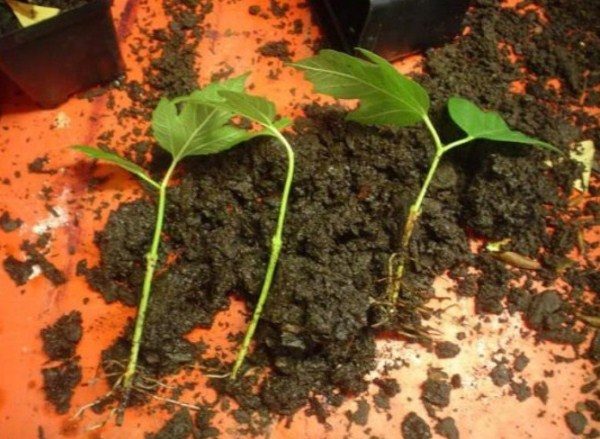
This method is suitable if viburnum is already growing in the country.
Breeding is done using cuttings, which have one internode. Prepare them in June, cutting the bushes. The shoots leave the length to 1 cm. Put in the humus. Stored in a greenhouse, covered with a film, which is removed only for watering. In such a humid environment, the cuttings remain until spring. For rearing do a special bed-school. When the bushes take root, you can begin to transplant to a permanent place in the ground.
There is another way of reproduction of decorative viburnum, when using seedlings with roots. It should be borne in mind that the crown of a tree or bush has a considerable width. The distance between them is set at 2 m. The root neck is 5 centimeters deep. Sealing the ground is well watered.
Varieties of decorative viburnum
A plant with a stem form looks quite interesting. Krona is formed around the shoot at a height of at least one and a half meters, leaving branches in 30 cm. Thin out it after 7 years, and cut off only the seedlings at the bottom of the tree.
In the south of Russia As a border and fences grow laurel Kalina. On the slopes of the mountains you can see thickets of fork. Delicious black fruit has pridewhich is found in deciduous forests.
- Kalina Fork
- Kalina Gordovina
- Eucalyptus viburnum
- Kalina Eskimo on the trunk
The most beautiful inflorescences possesses Buldenezh. It takes root even in Siberia. You can admire the white buds of a plant only by creating suitable conditions.
